Swift 5.1
func centerItemsInCollectionView(cellWidth: Double, numberOfItems: Double, spaceBetweenCell: Double, collectionView: UICollectionView) -> UIEdgeInsets {
let totalWidth = cellWidth * numberOfItems
let totalSpacingWidth = spaceBetweenCell * (numberOfItems - 1)
let leftInset = (collectionView.frame.width - CGFloat(totalWidth + totalSpacingWidth)) / 2
let rightInset = leftInset
return UIEdgeInsets(top: 0, left: leftInset, bottom: 0, right: rightInset)
}
Swift 4.2
func collectionView(_ collectionView: UICollectionView, layout collectionViewLayout: UICollectionViewLayout, insetForSectionAt section: Int) -> UIEdgeInsets {
let totalCellWidth = 80 * collectionView.numberOfItems(inSection: 0)
let totalSpacingWidth = 10 * (collectionView.numberOfItems(inSection: 0) - 1)
let leftInset = (collectionView.layer.frame.size.width - CGFloat(totalCellWidth + totalSpacingWidth)) / 2
let rightInset = leftInset
return UIEdgeInsets(top: 0, left: leftInset, bottom: 0, right: rightInset)
}
Swift 3
func collectionView(_ collectionView: UICollectionView, layout collectionViewLayout: UICollectionViewLayout, insetForSectionAtIndex section: Int) -> UIEdgeInsets {
let totalCellWidth = 80 * collectionView.numberOfItems(inSection: 0)
let totalSpacingWidth = 10 * (collectionView.numberOfItems(inSection: 0) - 1)
let leftInset = (collectionView.layer.frame.size.width - CGFloat(totalCellWidth + totalSpacingWidth)) / 2
let rightInset = leftInset
return UIEdgeInsetsMake(0, leftInset, 0, rightInset)
}
no olvides agregar el protocolo
UICollectionViewDelegateFlowLayout

